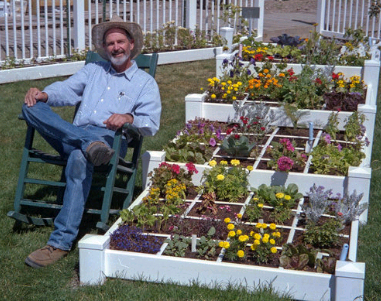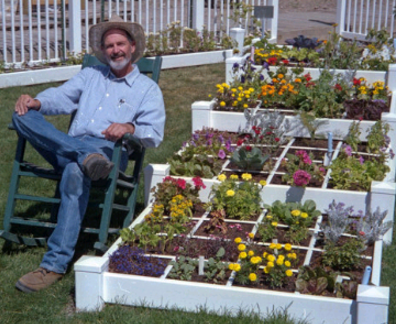What is square foot gardening? A simple, unique and versatile system that adapts to all levels of experience, physical ability, and geographical location. Grow all you want and need in only 20% of the space of a conventional row garden. Save time, water, work and money! I am following the square foot gardening method, and I'll be using it as a reference through out the blog. Square foot gardening invented by the genius Mel Bartholomew! Learn more about it in his website , Or order his very very valuable book. It may come in downloadable PDF files too, if you search. 
Here are the 10 things that make SFG different from traditional row gardening:
- Layout. Arrange your garden in squares, not rows. Lay it out in 4′x4′ planting areas. Companion plants can help each other grow bigger and tastier!
- Boxes. Build boxes to hold a new soil mix above ground. Your existing soil doesn't matter! forget about it, and just worry about the new soil called Mel's Mix.
- Aisles. Space boxes 3′ apart to form walking aisles. It makes it easier to walk and sit around the boxes, especially when your plants get really big and spill out of the boxes a little.
- Soil. Fill boxes with Mel’s special soil mix: 1/3 blended compost (please please make your own! The compost sold in Kuwait is a little shady) , 1/3 peat moss, and 1/3 coarse vermiculite (All available in True Value).
- Grid. Make a permanent square foot grid for the top of each box. A MUST!
- Care. NEVER WALK ON YOUR GROWING SOIL. This is how the soil stays so fluffy and airy for the roots stay happy. Tend your garden from the aisles.
- Select. Plant a different flower, vegetable, or herb crop in each square foot, using 1, 4, 9, or 16 plants per square foot. You might, for example, plant a single tomato in a square, but you’d plant 16 carrots in another. Using this system, you can cram a lot of garden into a small space and still get excellent yields.
- Plant. Conserve seeds. Plant only a pinch (2 or 3 seeds) per hole. Place transplants in a slight saucer-shaped depression. This means you wont waste seeds! The traditional way is to plant lots of seeds then cut off the majority and leave the strongest.
- Water. Water by hand from a bucket of sun-warmed water.
- Harvest. When you finish harvesting a square foot, add only compost and replant it with a new and different crop.
 I decided how big of an area I want to use, I am placing my SFG on the roof of my house, which I made sure received at least 8 hours of full sun. I am going big and starting with lots of boxes. So after thorough planning I decided I want two 4x4 square foot boxes (which is the standard) two smaller boxes for root vegetables like carrots and potatoes, and one long box for herbs. You can download the guide I created for the carpenters here . Its not the most accurate illustration of what the boxes look like in the end, but the numbers are right.
I decided how big of an area I want to use, I am placing my SFG on the roof of my house, which I made sure received at least 8 hours of full sun. I am going big and starting with lots of boxes. So after thorough planning I decided I want two 4x4 square foot boxes (which is the standard) two smaller boxes for root vegetables like carrots and potatoes, and one long box for herbs. You can download the guide I created for the carpenters here . Its not the most accurate illustration of what the boxes look like in the end, but the numbers are right. You can change the measurements how ever you like, most importantly, you have to make sure each square is 1ft squared in size= 30 cm. Also Most vegetables require 6 inches of soil, I've decided to use around 20cm. If the boxes are placed over a garden/soil, they don't need bottoms. In my case, I have to apply bottoms since they're going to be in the roof. The bottoms are waterproof 2cm thick plywood. The plywood has to have around 0.6 cm holes drilled in each square, plus in the corners. My boxes have weird squares in the plywood because the carpenter mistook 0.6cm for huge 6cm holes, I had them fix them without problems. Potato/Carrot beds:
You can change the measurements how ever you like, most importantly, you have to make sure each square is 1ft squared in size= 30 cm. Also Most vegetables require 6 inches of soil, I've decided to use around 20cm. If the boxes are placed over a garden/soil, they don't need bottoms. In my case, I have to apply bottoms since they're going to be in the roof. The bottoms are waterproof 2cm thick plywood. The plywood has to have around 0.6 cm holes drilled in each square, plus in the corners. My boxes have weird squares in the plywood because the carpenter mistook 0.6cm for huge 6cm holes, I had them fix them without problems. Potato/Carrot beds:  One of the 4x4' beds with the herb bed:
One of the 4x4' beds with the herb bed:  You can of course build your own boxes, and a very detailed guide is in the book. Im sure its much more fun.I don't have the skill or time, so I had the boxes done for 50KD total, 30 for the wood and 20 for the building. The work was done by Ibrahim in Classic Design Carpentry :
You can of course build your own boxes, and a very detailed guide is in the book. Im sure its much more fun.I don't have the skill or time, so I had the boxes done for 50KD total, 30 for the wood and 20 for the building. The work was done by Ibrahim in Classic Design Carpentry :  Don't forget, you can collect sawdust for free and use it as a carbon source in your compost! Maybe I'll paint the outsides of the boxes with the kids before the season starts, what do you think?
Don't forget, you can collect sawdust for free and use it as a carbon source in your compost! Maybe I'll paint the outsides of the boxes with the kids before the season starts, what do you think?


25001 comments
northwest pharmacy canada universal drugstore canada cheap cialis no prescription canadian pharmacy without perscription blackcialis.net Click Here – www.BlackCialis.net
Жаль, что сейчас не могу высказаться – опаздываю на встречу. Освобожусь – обязательно выскажу своё мнение.
Preto {my|nas obchod|nasa webova stranka} {Ponuka|odporucame|predava} {iba|iba} {cestny|slusny} a {priaznive|prijatelne|preferencne} podmienky. {preto|z tohto dovodu|z tohto dovodu} budeme {tiez|podobne|tiez} studovat tento detail a skontrolovat #file_links[“C:\Users\Admin\Desktop\file\gsa+sk+lomspirogiSK86c5y31ue1P2URLBB.txt”,1,N] a {ako|ako siroky je ich {cislo|Zoznam|Zoznam|sortiment}.
Scientists discovered something alarming seeping out from beneath the ocean around Antarctica
[url=https://1-consult.net/companies/cernye-brokery/life-is-good]русское гей порно[/url]
Planet-heating methane is escaping from cracks in the Antarctic seabed as the region warms, with new seeps being discovered at an “astonishing rate,” scientists have found, raising fears that future global warming predictions may have been underestimated.
Huge amounts of methane lie in reservoirs that have formed over millennia beneath the seafloor around the world. This invisible, climate-polluting gas can escape into the water through fissures in the sea floor, often revealing itself with a stream of bubbles weaving their way up to the ocean surface.
http://zvidalumkaser.ru/ugolovnyy-kodeks-n-63-fz-st-111-uk-rf/
жесток порно видео
Relatively little is known about these underwater seeps, how they work, how many there are, and how much methane reaches the atmosphere versus how much is eaten by methane-munching microbes living beneath the ocean.
But scientists are keen to better understand them, as this super-polluting gas traps around 80 times more heat than carbon dioxide in its first 20 years in the atmosphere.
Methane seeps in Antarctica are among the least understood on the planet, so a team of international scientists set out to find them. They used a combination of ship-based acoustic surveys, remotely operated vehicles and divers to sample a range of sites in the Ross Sea, a bay in Antarctica’s Southern Ocean, at depths between 16 and 790 feet.
What they found surprised them. They identified more than 40 methane seeps in the shallow water of the Ross Sea, according to the study published this month in Nature Communications.
Bubbles rising from a methane seep at Cape Evans, Antarctica. Leigh Tate, Earth Sciences New Zealand
Many of the seeps were found at sites that had been repeatedly studied before, suggesting they were new. This may indicate a “fundamental shift” in the methane released in the region, according to the report.
Methane seeps are relatively common globally, but previously there was only one confirmed active seep in the Antarctic, said Sarah Seabrook, a report author and a marine scientist at Earth Sciences New Zealand, a research organization. “Something that was thought to be rare is now seemingly becoming widespread,” she told CNN.
Every seep they discovered was accompanied by an “immediate excitement” that was “quickly replaced with anxiety and concern,” Seabrook said.
The fear is these seeps could rapidly transfer methane into the atmosphere, making them a source of planet-heating pollution that is not currently factored into future climate change predictions.
The scientists are also concerned the methane could have cascading impacts on marine life.
[url=https://nwstairs.ru/]дешевые лестницы[/url]